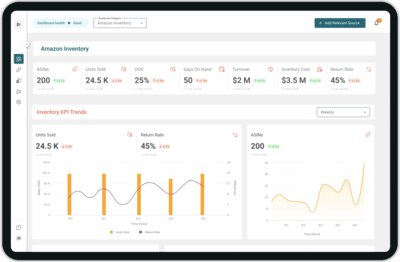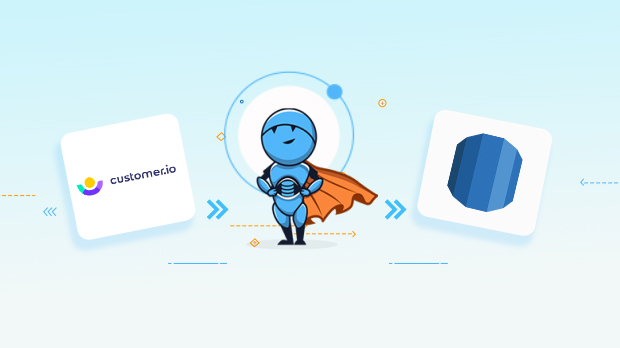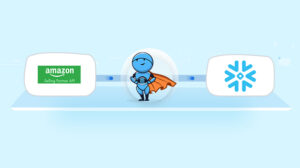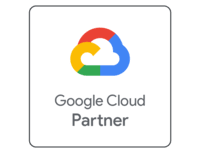Replicate Customer.io to Amazon Redshift in minutes
Are you looking for a quicker way to transfer data from Customer.io to Amazon Redshift? Here is an easy solution for this data migration process using a cloud data pipeline: Daton.
It has become essential for all eCommerce companies to look at their data deeply and leverage this for growth. Customer.io generates data like open rates, contact tracking, clicks, contact list, email campaign details, events that need to be analyzed, product demand, and user behavior data to reduce losses. You need to tally this data with data from other apps like customer support platforms, websites, inventory management, payment gateways, and CRMs. These data need to be analyzed for a complete understanding of the business and to identify improvement areas. Online retailers are trying to reduce the effort of complex data analysis and reporting by integrating these massive amounts of data using a cloud data pipeline like Daton.
Why integrate Customer.io to Amazon Redshift?
Customer.io is a popular marketing automation solution that facilitates automated email, push notifications, and SMS campaigns. The platform provides data on call-to-action buttons, clicks on ads, fast-moving products, customer feedback, and products with payment issues. It can help you determine your target audience, understand your product demands and optimize your advertisement budgets & strategies. This data will give a clear picture of how the ad campaigns are performing. But how will you strategize your future campaigns effectively to maximize profit?
Extract data from your social media campaigns, Google Ads, Sales Database, Inventory management systems, payment gateways, and other useful applications into a data warehouse and analyze that data frequently. You can also identify the right customers for your products using data generated from various sources, whom you can approach through engaging ad campaigns using Customer.io. The process of manual extraction & storage of all the data takes up a considerable amount of time. This time delay results in a loss of revenue for businesses. So, data-savvy brands invest in a cloud data pipeline like Daton. It is a highly automated data pipeline that easily migrates Customer.io to Amazon Redshift without any coding or maintenance.
Customer.io Overview
Customer.io is an online marketing automation solution for all platforms and media channels. It will help you to analyze how your clients are interacting with the ad campaigns. You will get notifications whenever clients click on an enclosed link, open or read your mails. This data on customer interaction will reveal the relevance of the marketing operations. You can also send engaging newsletters to existing clients. Customer.io can send a specific email that is automatically triggered whenever the software observes a particular action. The analytics from the platform can be useful to study market trends. Over 900 Brands use Customer-io to make uninterrupted and seamless interaction with their clients.
Amazon Redshift Overview
Amazon Redshift is the most popular data warehouse to offer a cloud-native, petabyte-scale service. The software provides a query engine for all users allowing SQL based querying and a host of business intelligence tools to connect with the service. Amazon Redshift is built on a scalable infrastructure, supports big data and massive workloads. The powerful management console enables connections from any SQL client. Amazon Redshift service also supports REST APIs allowing developers to work in real-time with simple API calls. It is compatible with several BI and visualization tools.
How to replicate Customer.io to Amazon Redshift?
There are two ways in which you can replicate Customer.io to Amazon Redshift warehouse.
Build Your data pipeline – Building an in-house data pipeline needs a lot of experience, time and manpower with higher chances of errors. You need to extract data using Customer.io APIs & then connect it properly with the Amazon Redshift data warehouse.
Use Daton to integrate Customer.io & Amazon Redshift – Using Daton to integrate Customer.io & Amazon Redshift is the fastest & easiest way to save your time and efforts. Leveraging an eCommerce data pipeline like Daton simplifies and accelerates the time to build automated reporting to a great extent.
Configuring data replication on Daton on only takes a few minutes and a few clicks. Analysts do not have to write any code or manage any infrastructure, yet they can get access to their Customer.io data in a few hours. Daton’s simple and easy to use interface allows analysts and developers to use UI elements to configure data replication from Customer.io data into Amazon Redshift.
Daton takes care of:
- Authentication
- Rate limits,
- Table creation, deletion & reloads
- Refreshing access tokens,
- Sampling,
- Historical data load,
- Incremental data load,
- Notifications
and many more important functions for data analysts to focus on analysis rather than worry about the data replication.
Steps to Integrate Customer.io with Daton

- Sign in to Daton
- Select Customer.io from the Integrations page
- Provide Integration Name, Replication Frequency, and History. The integration name would be used in creating tables for the integration and cannot be changed later
- You will be redirected to Customer.io login for authorizing Daton to extract data periodically
- Post successful authentication, you will be prompted to choose from the list of available Customer.io accounts
- Select required tables from the available list of tables
- Then select all required fields for each table
- Submit the integration
For more information, visit Customer.io Connector.
Sign up for a trial of Daton Today!
Here are more reasons to explore Daton for Customer.io to Amazon Redshift Integration
- Faster Integration of Customer.io to Amazon Redshift– Customer.io to Amazon Redshift is one of the integrations Daton can handle very fast and seamlessly. By following few steps, you can easily connect Customer.io to Amazon Redshift.
- Robust Scheduling Options: allows you to schedule jobs based on their requirements using a simple configuration step.
- Low Effort & Zero Maintenance – Daton automatically takes care of all the data replication processes and infrastructure once you sign up for a Daton account and configure the data sources. There is no infrastructure to manage or no code to write.
- Data consistency guarantee and an incredibly friendly customer support team ensure you can leave the data engineering to Daton and focus instead of analysis and insights!
- Enterprise grade data pipeline at an unbeatable price to help every business become data driven. Get started with a single integration today for just $10 and scale up as your demands increase.
- Support for all major cloud data warehouses including Google Bigquery, Snowflake, Amazon Redshift, Oracle Autonomous Data Warehouse, PostgreSQL and more.
- Flexible loading options allows to you optimize data loading behavior to maximize storage utilization and easy of querying.
- Enterprise grade encryption gives your peace of mind
- Support for 100+ data sources – In addition to Customer.io, Daton can extract data from a varied range of sources such as Sales and Marketing applications, Databases, Analytics platforms, Payment platforms and much more. Daton will ensure that you have a way to bring any data to Amazon Redshift and generate relevant insights.
For all sources, check our data connectors page.
Other Articles by Saras Analytics,














